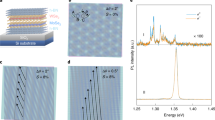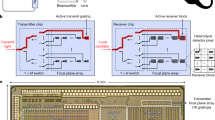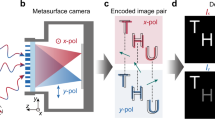Abstract
Sensors that are capable of three-dimensional detection of depth field information in the spatial ___domain are of potential use in applications such as robotics, satellite imaging and medical assistance. However, current techniques require a precise light source for complex phase detection and diffraction, or involve static multidirectional reflection imaging. Here we report a reconfigurable heterostructure transistor array for monocular three-dimensional parallax reconstruction. The phototransistors are based on heterostructures of indium gallium zinc oxide and tungsten diselenide, and can operate as n-type, p-type or ambipolar transistors depending on electrostatic modulation. The arrays can be switched between two modes: a real-time constant perception mode for static imaging and a spatiotemporal planar configuration mode with memory for dynamic imaging. To switch between the modes, the dominant carrier polarity is changed via a complementary metal–oxide–semiconductor-compatible multiterminal addressing architecture. We show that the system can be used for three-dimensional morphology reconstruction, two-dimensional depth field mapping and multi-view coupling.
This is a preview of subscription content, access via your institution
Access options
Access Nature and 54 other Nature Portfolio journals
Get Nature+, our best-value online-access subscription
27,99 € / 30 days
cancel any time
Subscribe to this journal
Receive 12 digital issues and online access to articles
118,99 € per year
only 9,92 € per issue
Buy this article
- Purchase on SpringerLink
- Instant access to full article PDF
Prices may be subject to local taxes which are calculated during checkout




Similar content being viewed by others
Data availability
The data that support the findings of this study are available via Figshare at https://doi.org/10.6084/m9.figshare.26764015 (ref. 41). Source data are provided with this paper.
Code availability
The code used for image reconstruction is available from the corresponding author on reasonable request.
References
Wu, J. et al. An integrated imaging sensor for aberration-corrected 3D photography. Nature 612, 62–71 (2022).
Lien, M. et al. Ranging and light field imaging with transparent photodetectors. Nat. Photonics 14, 143–148 (2020).
Feng, X., Ma, Y. & Gao, L. Compact light field photography towards versatile three-dimensional vision. Nat. Commun. 13, 3333 (2022).
Jing, X. et al. Single-shot 3D imaging with point cloud projection based on metadevice. Nat. Commun. 13, 7842 (2022).
Huang, L. et al. Three-dimensional optical holography using a plasmonic metasurface. Nat. Commun. 4, 2808 (2013).
Park, J., Lee, K. & Park, Y. Ultrathin wide-angle large-area digital 3D holographic display using a non-periodic photon sieve. Nat. Commun. 10, 1304 (2019).
Vamvakeros, A. et al. 5D operando tomographic diffraction imaging of a catalyst bed. Nat. Commun. 9, 4751 (2018).
Li, J. et al. Rapid sensing of hidden objects and defects using a single-pixel diffractive terahertz sensor. Nat. Commun. 14, 6791 (2023).
Cherukara, M. J. et al. Three-dimensional X-ray diffraction imaging of dislocations in polycrystalline metals under tensile loading. Nat. Commun. 9, 3776 (2018).
Yi, L., Hou, B., Zhao, H. & Liu, X. X-ray-to-visible light-field detection through pixelated colour conversion. Nature 618, 281–286 (2023).
Shen, Z. et al. Monocular metasurface camera for passive single-shot 4D imaging. Nat. Commun. 14, 1035 (2023).
Huang, X. et al. Polarization structured light 3D depth image sensor for scenes with reflective surfaces. Nat. Commun. 14, 6855 (2023).
Fang, J., Huang, K., Wu, E., Yan, M. & Zeng, H. Mid-infrared single-photon 3D imaging. Light Sci. Appl. 12, 144 (2023).
Zhang, X., Kwon, K., Henriksson, J., Luo, J. & Wu, M. C. A large-scale microelectromechanical systems-based silicon photonics LiDAR. Nature 603, 253–258 (2022).
Rogers, C. et al. A universal 3D imaging sensor on a silicon photonics platform. Nature 590, 256–261 (2021).
Goossens, S. et al. Broadband image sensor array based on graphene-CMOS integration. Nat. Photonics 11, 366–371 (2017).
Zhang, Z. A flexible new technique for camera calibration. IEEE T. Pattern. Anal. 22, 1330–1334 (2000).
Tachella, J. et al. Real-time 3D reconstruction from single-photon lidar data using plug-and-play point cloud denoisers. Nat. Commun. 10, 4984 (2019).
Zhou, K. et al. Parallelized computational 3D video microscopy of freely moving organisms at multiple gigapixels per second. Nat. Photon. 17, 442–450 (2023).
Siavashani, M. et al. 3D imaging using scanning diffractometry. Sci. Rep. 11, 482 (2021).
Scholler, J. et al. Dynamic full-field optical coherence tomography: 3D live-imaging of retinal organoids. Light Sci. Appl. 9, 140 (2020).
Ozyesil, O., Voroninski, V., Basri, R. & Singer, A. A survey of structure from motion. Acta Numer. 26, 305–364 (2017).
Schonberger, J. L. & Frahm, J. Structure-from-motion revisited. In Proc. IEEE Conference on Computer Vision and Pattern Recognition (CVPR) 4104–4113 (IEEE, 2016).
Mennel, L. et al. Ultrafast machine vision with 2D material neural network image sensors. Nature 579, 62–66 (2020).
Lee, J. et al. Thin-film image sensors with a pinned photodiode structure. Nat. Electron. 6, 590–598 (2023).
Pan, C. et al. Reconfigurable logic and neuromorphic circuits based on electrically tunable two-dimensional homojunctions. Nat. Electron. 3, 383–390 (2020).
Choi, H. et al. A steep switching WSe2 impact ionization field-effect transistor. Nat. Commun. 13, 6076 (2022).
Seyler, K. L. et al. Electrical control of second-harmonic generation in a WSe2 monolayer transistor. Nat. Nanotechnol. 10, 407–411 (2015).
Pudasaini, P. R. et al. High-performance multilayer WSe2 field-effect transistors with carrier type control. Nano Res. 11, 722–730 (2018).
Cong, X. et al. Interplay of valley polarized dark trion and dark exciton-polaron in monolayer WSe2. Nat. Commun. 14, 5657 (2023).
Ren, Y. et al. Recent advances in ambipolar transistors for functional applications. Adv. Funct. Mater. 29, 1902105 (2019).
Liao, F. et al. Bioinspired in-sensor visual adaptation for accurate perception. Nat. Electron. 5, 84–91 (2022).
Li, Z. et al. Parallel photoelectron storage and visual preprocessing based on nanowire defect engineering for image degradation. Adv. Funct. Mater. 34, 2304119 (2024).
Kellnhofer, P. et al. Motion parallax in stereo 3D: model and applications. ACM T. Graphic. 35, 176 (2016).
Sun, X. et al. Reconfigurable logic-in-memory architectures based on a two-dimensional van der Waals heterostructure device. Nat. Electron. 5, 752–760 (2022).
Chen, Y. et al. Ferroelectric-tuned van der Waals heterojunction with band alignment evolution. Nat. Commun. 12, 4030 (2021).
Liu, K. et al. An optoelectronic synapse based on α-In2Se3 with controllable temporal dynamics for multimode and multiscale reservoir computing. Nat. Electron. 5, 761–773 (2022).
Li, P. et al. Reconfigurable optoelectronic transistors for multimodal recognition. Nat. Commun. 15, 3257 (2024).
Lowe, D. G. Distinctive image features from scale-invariant keypoints. Int. J. Comput. Vision 60, 91–110 (2004).
Harris, C. & Stephens, M. A combined corner and edge detector. In Proc. Alvey Vision Conference (ed. Taylor, C. J.) 147–151 (Alvey Vision Club, 1988).
Li, Z. Source data. Figshare https://doi.org/10.6084/m9.figshare.26764015 (2024).
Acknowledgements
This work was supported by the National Natural Science Foundation of China (grant nos. 62422409, 62174152 and 62374159). The authors acknowledge financial support from Open Fund of State Key Laboratory of Infrared Physics (grant no. SITP-NLIST-YB-2024-04) and the Youth Innovation Promotion Association of the Chinese Academy of Sciences (grant no. 2020115). Thanks to J. Chang (Institute of Semiconductors, CAS) for technical guidance of etching process and thanks to J. Chen (Institute of Semiconductors, CAS) for technical guidance of spectrum characterization.
Author information
Authors and Affiliations
Contributions
Z. Li, Z. Lou and L.W. designed the research, Z. Li and L.W. wrote the paper, Z. Li, H.X., Y.Z., L. Liu and L. Li performed the experiments, Z. Li and L. Li performed the first-principles calculations and simulation. Z. Li, L. Liu and Z. Lou analysed the data. Z. Lou and L.W. revised the paper, Z. Lou and L.W. supervised the project. All authors contributed to research and reviewed the manuscript.
Corresponding authors
Ethics declarations
Competing interests
The authors declare no competing interests.
Peer review
Peer review information
Nature Electronics thanks Jongchan Park and the other, anonymous, reviewer(s) for their contribution to the peer review of this work.
Additional information
Publisher’s note Springer Nature remains neutral with regard to jurisdictional claims in published maps and institutional affiliations.
Supplementary information
Supplementary Information
Supplementary Notes 1–4, Figs. 1–26 and Tables 1 and 2.
Supplementary Data
Source data for supplementary figures.
Source data
Source Data Figs. 1–4
Statistical source data.
Rights and permissions
Springer Nature or its licensor (e.g. a society or other partner) holds exclusive rights to this article under a publishing agreement with the author(s) or other rightsholder(s); author self-archiving of the accepted manuscript version of this article is solely governed by the terms of such publishing agreement and applicable law.
About this article
Cite this article
Li, Z., Xu, H., Zheng, Y. et al. A reconfigurable heterostructure transistor array for monocular 3D parallax reconstruction. Nat Electron 8, 46–55 (2025). https://doi.org/10.1038/s41928-024-01261-6
Received:
Accepted:
Published:
Issue Date:
DOI: https://doi.org/10.1038/s41928-024-01261-6
This article is cited by
-
Efficient 3D imaging with reconfigurable sensors
Nature Electronics (2025)
-
An epidermal serine sensing system for skin healthcare
Nature Communications (2025)
-
Ambipolar two-dimensional materials-based reconfigurable devices
Science China Materials (2025)



